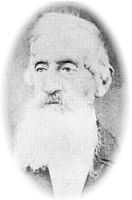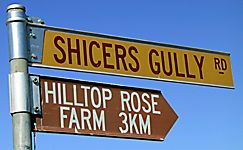![]()
| Intro 1 | Intro 2 | Bendigo | Ballerstedt | Eureka Rebellion | Frederick Vern | German Poem |
| Hermann Bruhn & the first gold discovery | shicers | eighth-largest nugget | German Associations |
A Gold Rewards Committee of the Victorian Parliament offered a reward in 1851 to the first person discovering gold within 200 miles of Melbourne. The bigwigs in Victoria were scared that all the workers in the new colony of Victoria (just separated from New South Wales) would flood north to the goldfields recently found in NSW.
 In
January 1851 Dr Hermann Bruhn, a doctor, had set out from Melbourne on a six-month
journey through the bush, to explore the mineral resources of Victoria. Hearing
from shepherds that they had known for a long time of a gold-bearing quartz
vein on Donald Cameron's sheep station "Clunes", he visited Cameron
and was shown gold specimens. While travelling he met James Esmond, and told
him of the gold at "Clunes". On 18th July 1851 Bruhn wrote a letter
in German to Victoria's Governor La Trobe (La Trobe was of course an educated
man) reporting on his discoveries during his journey. The Gold Rewards Committee
awarded Dr Bruhn £500 in recognition of his journey and for having publicised
the Clunes gold discovery everywhere he went during his expedition (rather than
keeping it to himself). Two other people including James Esmond received rewards
for Clunes also, as the committee felt that all three had legitimate claims
to the reward. James Esmond (who already had mining experience on the Californian
gold fields) is usually known as the first discoverer of gold in Victoria because
he went up to Clunes with mining equipment and dug there himself, triggering
a rush.
In
January 1851 Dr Hermann Bruhn, a doctor, had set out from Melbourne on a six-month
journey through the bush, to explore the mineral resources of Victoria. Hearing
from shepherds that they had known for a long time of a gold-bearing quartz
vein on Donald Cameron's sheep station "Clunes", he visited Cameron
and was shown gold specimens. While travelling he met James Esmond, and told
him of the gold at "Clunes". On 18th July 1851 Bruhn wrote a letter
in German to Victoria's Governor La Trobe (La Trobe was of course an educated
man) reporting on his discoveries during his journey. The Gold Rewards Committee
awarded Dr Bruhn £500 in recognition of his journey and for having publicised
the Clunes gold discovery everywhere he went during his expedition (rather than
keeping it to himself). Two other people including James Esmond received rewards
for Clunes also, as the committee felt that all three had legitimate claims
to the reward. James Esmond (who already had mining experience on the Californian
gold fields) is usually known as the first discoverer of gold in Victoria because
he went up to Clunes with mining equipment and dug there himself, triggering
a rush.
(Image: a copy held by the Society of Australian Genealogists in the Dennes papers, made from the original print.)
![]()
By 1854, of a total gold fields population of about 66,700, 2.46% were German. Of all the Germans in Victoria, nearly 42% were looking for gold.
 Road sign near Guildford, central Victoria |
Shicers: In Raffaello Carboni's book about his experiences on the goldfields before, during and after the Eureka Stockade, he uses a word spelled both as "shicer" and as "scheisser", which was a word miners used for a claim that produced no gold (it was derived from the German verb scheissen). Parties of diggers who were not having much luck would drink a toast (with rotgut rum from a sly-grog seller) "To our last bloody shicer!", in the hope that they would soon dig a successful hole. In November 1855 a gold field was opened near Blackwood that was known as Shicer Gully. There were two Shicer Gullys in the Castlemaine area, and a gold field named Shicer Gully was opened at Wedderburn in 1853, and another Shicer Gully was opened at Smythesdale in August 1860. |
There's a good time a comin', boys, a good time a comin',
Not a shicer shall be sunk, nor a digger ever seen drunk,
And there's a good time a comin'...- "The Good Time Coming": a song of hope from a collection of songs written by William Coxon in Ballarat ~1858-9.
Ferdinand Hochstetter wrote down what he observed of mining when on a visit to Victoria in 1859. He wrote in his diary: "Schicer R[eef] (Deutsches Wort!!)" (German word!!).
![]()
On 31st May 1870 on the Berlin-Rheola diggings, S. Schlossmann, J. Davis and another miner named Rendisch dug up the eighth-largest gold nugget ever found in Victoria; it was named the Viscount Canterbury and weighed 1114 troy ounces (34.6 kg).
| Top | Back
| Chronology | Issues
| Students | Site Map |
auf Deutsch |
| Primary Sources (in German) | Bibliography
| Search |
German Australia © D. Nutting 2001